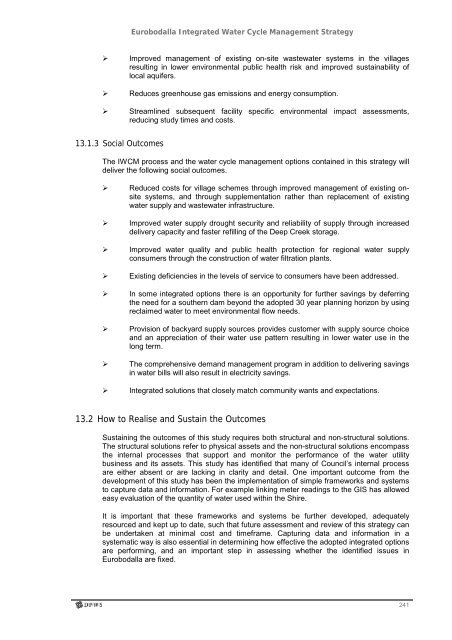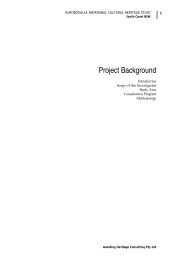Eurobodalla Integrated Water Cycle Management Strategy
Eurobodalla Integrated Water Cycle Management Strategy
Eurobodalla Integrated Water Cycle Management Strategy
You also want an ePaper? Increase the reach of your titles
YUMPU automatically turns print PDFs into web optimized ePapers that Google loves.
<strong>Eurobodalla</strong> <strong>Integrated</strong> <strong>Water</strong> <strong>Cycle</strong> <strong>Management</strong> <strong>Strategy</strong><br />
Improved management of existing on-site wastewater systems in the villages<br />
resulting in lower environmental public health risk and improved sustainability of<br />
local aquifers.<br />
Reduces greenhouse gas emissions and energy consumption.<br />
Streamlined subsequent facility specific environmental impact assessments,<br />
reducing study times and costs.<br />
13.1.3 Social Outcomes<br />
The IWCM process and the water cycle management options contained in this strategy will<br />
deliver the following social outcomes.<br />
Reduced costs for village schemes through improved management of existing onsite<br />
systems, and through supplementation rather than replacement of existing<br />
water supply and wastewater infrastructure.<br />
Improved water supply drought security and reliability of supply through increased<br />
delivery capacity and faster refilling of the Deep Creek storage.<br />
Improved water quality and public health protection for regional water supply<br />
consumers through the construction of water filtration plants.<br />
Existing deficiencies in the levels of service to consumers have been addressed.<br />
In some integrated options there is an opportunity for further savings by deferring<br />
the need for a southern dam beyond the adopted 30 year planning horizon by using<br />
reclaimed water to meet environmental flow needs.<br />
Provision of backyard supply sources provides customer with supply source choice<br />
and an appreciation of their water use pattern resulting in lower water use in the<br />
long term.<br />
The comprehensive demand management program in addition to delivering savings<br />
in water bills will also result in electricity savings.<br />
<strong>Integrated</strong> solutions that closely match community wants and expectations.<br />
13.2 How to Realise and Sustain the Outcomes<br />
Sustaining the outcomes of this study requires both structural and non-structural solutions.<br />
The structural solutions refer to physical assets and the non-structural solutions encompass<br />
the internal processes that support and monitor the performance of the water utility<br />
business and its assets. This study has identified that many of Council’s internal process<br />
are either absent or are lacking in clarity and detail. One important outcome from the<br />
development of this study has been the implementation of simple frameworks and systems<br />
to capture data and information. For example linking meter readings to the GIS has allowed<br />
easy evaluation of the quantity of water used within the Shire.<br />
It is important that these frameworks and systems be further developed, adequately<br />
resourced and kept up to date, such that future assessment and review of this strategy can<br />
be undertaken at minimal cost and timeframe. Capturing data and information in a<br />
systematic way is also essential in determining how effective the adopted integrated options<br />
are performing, and an important step in assessing whether the identified issues in<br />
<strong>Eurobodalla</strong> are fixed.<br />
241

















